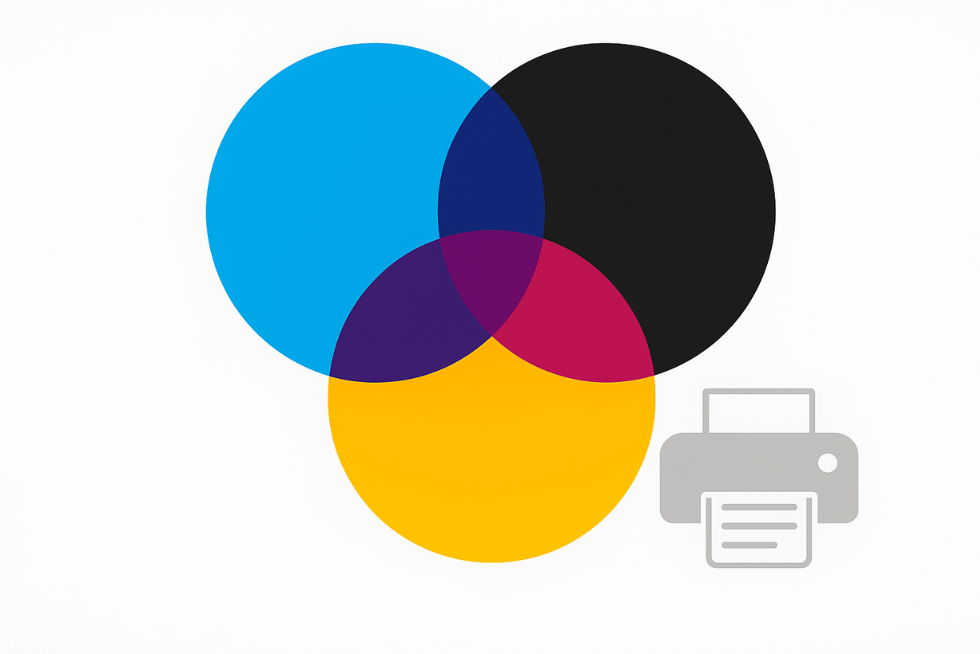Matching colors on screen and on print has always been one of the most challenging things to do in any design work. Every designer has felt the unjust feeling when a colorful design gets printed and turns dull. Knowing that understanding CMYK is the best armor against such disappointments.
Unlike RGB, which is used on the monitor to create illuminative colors, CMYK for print is used with physical pigments. It is the reason that the electric blue that is so light and bright on the screen turns into a muddy color on print. CMYK works by building colors with different DTF inks, which in turn absorb some wavelengths of light and reflect a couple back to the eye.
Going through the process seems complicated at the start, but with time, every process has logical reasoning. Cyan and yellow equal green color. Add some magenta and you get different green shades. Change the ratios and the color changes. Knowing how the 4 inks (Cyan, Magenta, Yellow, and Black) behave enables you to guess how your design will turn out.
How Professional Print Shops Handle CMYK
The production workflow starts with color separation - breaking your design into four separate channels, one for each ink. This separated file then goes through RIP software (Raster Image Processor) that translates your digital artwork into instructions the printer can understand.
At Mad Monkey Transfers, we use different RIP programs depending on the job requirements. CADlink handles most routine work efficiently, while PrintFactory gives us the advanced color control needed for challenging projects. Our equipment includes both 9 and 4 color DTF machines, which are mostly for every type of customized DTF transfers, allowing flexibility based on the complexity and volume of each job.
The choice of equipment matters because different printers handle color reproduction differently. A 9 color system can produce smoother gradients and more accurate skin tones than a 4 color setup, but it's overkill for simple logo work. Understanding these nuances helps us match the right equipment to each project.
Why RGB Files Cause Problems
RGB works by adding colored light - red, green, and blue combine to create other colors, with all three at full intensity producing white light. CMYK does the opposite, removing light from white paper by adding pigments that absorb specific wavelengths.
This creates a fundamental mismatch. RGB could display colors that don't really exist in the CMYK world, particularly bright, saturated colors like electric blues or neon greens. When conversion software encounters these "out-of-gamut" colors, it makes its best guess at a CMYK equivalent, often with dull results.
We see this problem constantly with files from design platforms like Canva. These tools work great for digital applications, but they don't prepare artwork for physical printing realities. Every RGB file we receive gets converted to our Printwide2020.icc color profile, which helps, but starting with CMYK gives much better control over the final result.
Color Profile Strategy
Not all CMYK is created equal. Different color settings define how the same CMYK values will actually appear when printed. U.S. Web Coated (SWOP) v2 works well for standard commercial printing, while GRACoL 2006 and the European Fogra standards serve their respective markets effectively.
We chose Printwide2020.icc because it offers a larger color gamut than traditional CMYK profiles. This means we can reproduce richer reds, deeper blues, and more vibrant greens than standard profiles allow. The profile also aligns with G7 standards, ensuring consistent results across different devices and substrates.
The technical details matter less than the practical result: using the right color profile means your prints look the way you intended them to look. When we embed Printwide2020.icc into every job, we eliminate most color consistency issues, even when switching between different machines or materials.
Practical Color Management
Understanding which colors work well in CMYK can save significant time and frustration. Rich black, created by mixing cyan, magenta, yellow, and black rather than using pure black ink, produces much more solid-looking dark areas. The exact formula varies, but something like 60% cyan, 40% magenta, 40% yellow, and 100% black typically works well.
Certain colors consistently cause problems. Bright neons and highly saturated colors often can't be reproduced accurately in CMYK. Electric blues, in particular, almost always disappoint when converted from RGB. Our color chart shows exactly how different CMYK combinations will print, taking the guesswork out of color selection.
We routinely use loupes to inspect print quality and run test samples before completing large jobs. This level of quality control catches problems early, when they're still fixable rather than expensive mistakes.
File Format Considerations
PDF remains the gold standard for CMYK printing because it preserves vector data, embedded color profiles, and layer information. This gives us maximum flexibility when adjustments are needed. Illustrator files work well for vector graphics, though they're less universal than PDF.
PNG files are commonly submitted and work acceptably, especially when transparency is required. However, they can't match the editability and resolution independence of vector formats. JPEG files present the most challenges - they don't support transparency and often introduce compression artifacts that become visible in high-quality printing.
Always include transparent backgrounds when your artwork needs to sit on colored garments or non-white surfaces. A logo with a white rectangle around it looks amateurish and defeats the purpose of custom printing.
The ICC Profile Solution
Color consistency across different devices and printing systems remains one of the biggest challenges in professional printing. ICC profiles solve this by standardizing how colors should appear, creating a translation system between digital values and physical ink output.
When prints come back looking "off," the problem often traces back to missing or mismatched ICC profiles. By embedding Printwide2020.icc into every job, we maintain consistent results regardless of which machine or material we use. This attention to detail explains why color complaints are rare in our shop.
Building Your Own Color Reference
Many designers find it helpful to create their own CMYK swatch libraries. The process involves setting up a CMYK document in Illustrator or Photoshop, entering various ink combinations with clear labels, then printing them to see actual results. This creates a personal reference that speeds up future design decisions.
If building a complete swatch set feels overwhelming, our pre-tested color chart provides the same benefit without the work. We've already verified how each color combination prints, so you can choose colors with confidence.
Understanding Transparency
Transparency confuses many people new to CMYK work. The color space itself doesn't manage transparency. That's handled by the file format. PDF and PNG files can include transparent elements, while JPEG files flatten everything to solid backgrounds.
Always double-check export settings when working with logos, watermarks, or designs that need transparent backgrounds. A design that looks perfect on screen can be ruined by incorrect transparency handling during export.
The Bigger Picture
CMYK print encompasses much more than just color mixing - it's an entire workflow that affects every aspect of print production. From initial file setup through ink behavior on different substrates, understanding CMYK principles helps you create better work consistently for printing even for UV DTF transfers.
Whether you're designing occasional custom pieces or managing large-scale print campaigns, taking CMYK seriously produces sharper, more consistent, and more professional results. The technical knowledge pays dividends in reduced reprints, happier clients, and designs that actually match your original vision.
At Mad Monkey Transfers, our entire process centers on getting color right the first time. That starts with understanding how CMYK works and continues through careful workflow management and quality control at every step.

